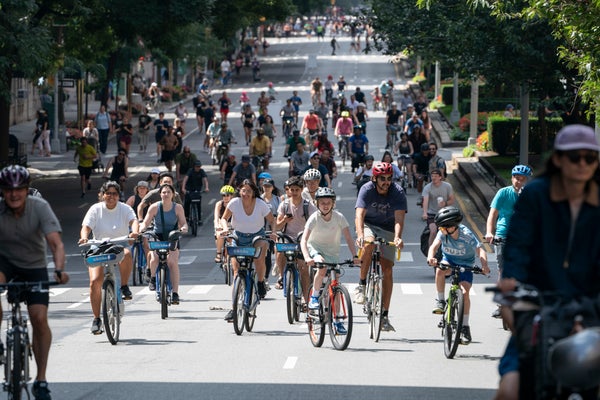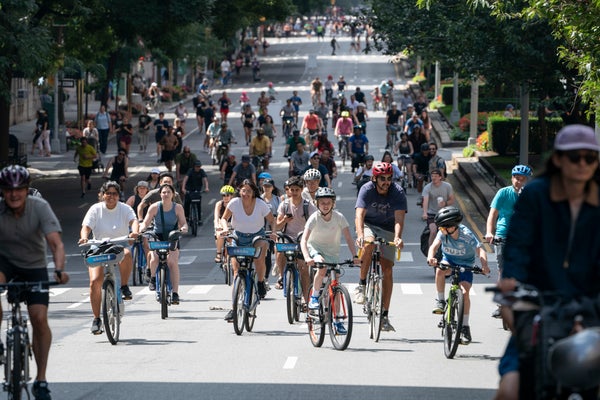We Need to Make Cities Less Car-Dependent
Reducing the need for car travel is better for health, the environment and public safety

Barry Williams for NY Daily News via Getty Images
In the 1970s a nation confronted a crisis of traffic deaths, many of them deaths of children. Protesters took to the streets to fight an entrenched culture of drivers who considered roads their domain alone. But this wasn’t the U.S.—it was the Netherlands. In 1975 the rate of traffic deaths there was 20 percent higher than in the U.S., but by the mid-2000s it had fallen to 60 percent lower than in the U.S. How did this happen?
Thanks to Stop de Kindermoord (“Stop Child Murder”), a Dutch grassroots movement, traffic deaths fell and streets were restored for people, not cars. Today the country is a haven for cyclists and pedestrians, with people of all ages commuting via protected bike lanes and walking with little fear of being run over. It’s time the U.S. and other countries followed that example.
The U.S. has the highest number of traffic deaths among wealthy countries, with more than 38,000 deaths per year between 2015 and 2019. The death rate is more than double the average rate in other wealthy countries. Vehicle crashes are among the leading causes of death in the U.S. But it doesn’t have to be this way. We can design or redesign streets to make people drive more slowly or to discourage driving altogether. We can invest in better public transit, including subways and buses with dependable, on-time service. And we can change zoning laws to allow denser housing and mixed-use developments, so people can live closer to where they work, attend school or socialize. These are changes that even the largest, most sprawling cities can and should implement.
On supporting science journalism
If you’re enjoying this article, consider supporting our award-winning journalism by subscribing. By purchasing a subscription you are helping to ensure the future of impactful stories about the discoveries and ideas shaping our world today.
Making these changes curbs air pollution, which causes millions of excess deaths worldwide every year, and reduces the amount of greenhouse gas we pump into the atmosphere with every drive to the grocery store. Traffic deaths and air pollution are social justice issues, disproportionately harming people of color. In addition, cities that are more car-dependent are often less accessible for the considerable part of the population that can’t drive, including children, people with disabilities, people who can’t afford a car or insurance, and many older people.
Many U.S. cities have abundant space for parking and wide, multilane “stroads,” a mix between a street (where cars move slowly and people can walk safely) and a road (where cars move fast, such as a highway). Stroads are optimized for moving many vehicles through an area at high speed. Yet widening or expanding the number of streets only incentivizes more people to drive, which creates more traffic.
At the same time, cars have gotten bigger and deadlier—SUVs and trucks now represent more than 80 percent of car sales in the U.S. If we want to give more space to pedestrians, cyclists and people using wheelchairs, we need to separate them from high-speed vehicles by building more well-maintained sidewalks, curbs with inclined cuts and protected bike lanes and by implementing traffic-calming measures such as narrower streets, speed bumps and traffic medians.
We should invest in improving public transit to make it an inviting alternative to cars. Buses need reliable schedules and dedicated lanes so they don’t get stuck in the traffic we’re trying to reduce. And expanding subways and other rail-based transit will help to bring in jobs and development.
Cities such as New York, Chicago and Philadelphia already have fairly good public transit and have increased the number of bike lanes and pedestrian-only areas. Early in the COVID pandemic, these and other cities implemented “open streets,” which block off most car traffic at certain times to make space for pedestrians, cyclists, playing children and outdoor diners. We need to ensure they can persist.
Minneapolis, a smaller city, added bike lanes and banned single-family zoning, a major contributor to urban sprawl. Ann Arbor, Mich., banned right turns on red—a dangerous practice that spread during the 1970s fuel crisis as a way to save gas—at 50 downtown intersections. Even in car-centric Tempe, Ariz., developers created a car-free neighborhood. More spread-out cities could focus on denser nodes or neighborhoods that have some public transit and build those out.
Too often efforts to reduce car dependence are met with fierce opposition by people who dismiss them as “socialism” or a “war on cars.” But drivers also benefit from many of these changes, which would reduce traffic and make driving safer. Others argue that these changes will harm people with disabilities, yet the opposite may be true—reduced car dependence, if paired with improved, disability-centered infrastructure, could make cities more accessible. And emergency vehicles aren’t much help to anyone if they’re stuck in traffic.
Creating better road designs and public transit will require significant up-front investment, and the effects may not be seen for years. But we could subsidize the cost the way we already subsidize driving. We could eliminate free parking. We could set up congestion pricing in dense city centers, as New York City plans to do, and use the proceeds to fund public transit alternatives. And we can add more bike lanes and open streets, which are cheaper to put in place and provide immediate benefits.
In much of the U.S., it is still illegal to build anything denser than single-family homes, and housing often has minimum parking requirements that take up valuable real estate. If we encourage cities to build duplexes, triplexes and apartment buildings, especially near transit hubs, fewer people will need cars.
The same solutions won’t work everywhere, and change won’t happen all at once. Each city has its own unique considerations and challenges. And such an ambitious project will require rethinking many of our assumptions about American car culture. But the benefits could make everyone healthier and safer.
This is an opinion and analysis article, and the views expressed by the author or authors are not necessarily those of Scientific American.

